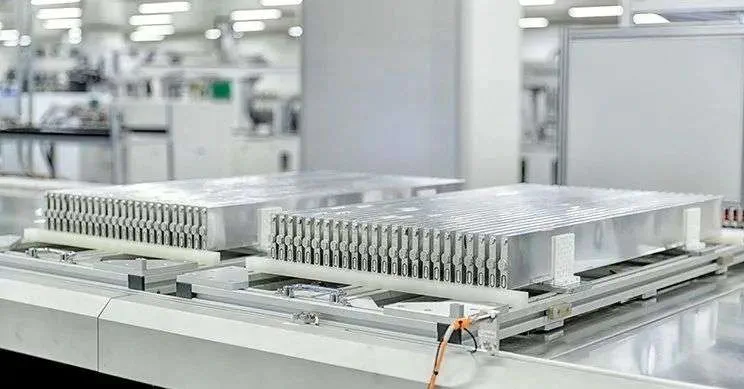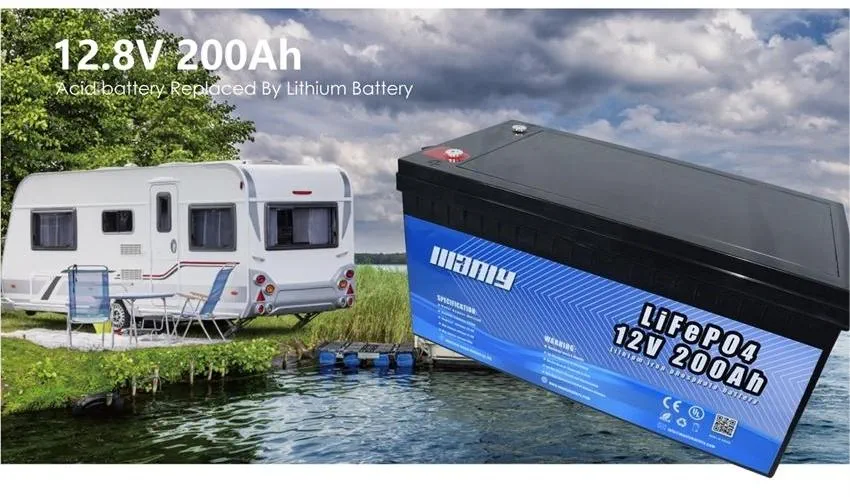2023 Guide: Best Deep Cycle Battery for Solar & RVs
Table of Contents
- 2023 Guide: Best Deep Cycle Battery for Solar & RVs
- 1. What Are Deep-Cycle Batteries and How Are They Used in RVs/Solar?
- 2. Key Factors to Consider When Selecting a Deep Cycle Battery
- 3. Top Deep Cycle Batteries for RVs and Solar
- 4. Lithium Deep Cycle Batteries – The Future of Energy Storage?
- 5. Maintaining and Charging Your Deep Cycle Batteries for Maximum Life
- 6. MANLY Battery Excellence
- 7.Conclusion
Are you prepared to travel in a solar-powered RV off the grid or to leave the city behind? It’s a fascinating voyage, but you’ll need excellent deep-cycle batteries to access the sun’s endless energy. These aren’t your typical batteries; they were created specifically to endure the challenges of solar and RV systems, where long-term power storage is crucial.
Choosing the ideal deep-cycle batteries could seem difficult, but don’t worry; we’re here to make it easier. In this thorough tutorial, we’ll take you through the nuances of selecting the proper deep-cycle battery type and size that are specifically catered to your solar or RV system needs. If you have the right batteries on hand, you can guarantee a smooth and continuous power supply for all your excursions, whether you’re traveling through rural areas or enjoying the freedom of the open road.
Deep-cycle batteries are the best option for your solar and RV projects since they are designed to tolerate frequent discharge and recharging. So read this post carefully and arm yourself with the information you need to remain motivated wherever your trip takes you. The options are numerous, and your experiences are limitless, when you use the sun as your energy source and high-quality deep-cycle batteries as your storage option.
1. What Are Deep-Cycle Batteries and How Are They Used in RVs/Solar?
Deep-cycle batteries can power electrical equipment for a long time since they are designed for continuous operation. Deep-cycle batteries, as opposed to regular car starting batteries, are designed to resist repeated discharge and recharge cycles. As a result, they are a solid option for uses like RVs and solar power systems, where a reliable and continuous power supply is crucial. Deep-cycle batteries make sure your demands are met with a dependable and long-lasting power source whether you’re traveling or using solar power..
1.1 What to consider when choosing deep-cycle batteries
There are a few considerations you need to make when purchasing deep-cycle batteries for your solar system or recreational vehicle, including the following:
1.2 Number of batteries
For RVs and solar, use at least two batteries connected in parallel to double the capacity. Four to six batteries are common for off-grid solar. Wire them correctly based on voltage.
1.3 Brand and warranty
Choose a reputable brand and look for at least a 3-5 year full replacement warranty. Some offer up to 10 years.
1.4 Cost
Expect to pay $100-500 or more per battery depending on the type and capacity. Buy the highest quality you can afford for the best performance and lifespan.
You will have an ample supply of power for your recreational vehicle or solar system if you choose the appropriate deep-cycle batteries and ensure that they are placed correctly. Spend some time thinking about what would meet your requirements while staying within your price range. Make an informed decision, since the batteries in your system are the most important component.
2. Key Factors to Consider When Selecting a Deep Cycle Battery
For optimum performance and dependability, take into account important parameters including capacity, voltage, size, and maintenance needs when choosing a deep cycle battery for your solar or RV system.
2.1 Battery type
Lead-acid batteries, including AGM (Absorbent Glass Mat) and gel cell batteries, and lithium-ion batteries are the two most popular choices for deep-cycle batteries for solar and RV installations. While lithium-ion batteries have better lifetime, lead-acid batteries are often more affordable. However, AGM batteries often end up being the favored option for many consumers looking for a balanced solution that combines price and performance. These batteries are a desirable choice for a variety of solar and RV applications because they successfully balance affordability and toughness.
2.2 Capacity
A battery’s capacity, which is commonly expressed in amp-hours (Ah), represents the amount of energy it can hold. A battery with a larger capacity has a bigger energy reserve and can generate electricity for longer before needing to be recharged. Targeting a capacity range of 200-400 Ah is often a wise decision, guaranteeing a dependable and consistent energy supply, to efficiently power vital circuits in an RV or cabin.
2.3 Voltage
A battery’s capacity to supply electricity instantly depends on its voltage. Common systems in the world of RVs and solar arrangements run at either 12V or 24V. While 24V installations may support more powerful devices, they need specific parts. A 12-volt lithium battery is often advised as a simple and useful starting point since it strikes a balance between adaptability and usability in most applications.
2.4 Lifespan
Over time, deep-cycle batteries naturally lose some of their capacity to hold a charge. AGM and gel cell batteries typically have a life expectancy of three to five years, although lithium-ion batteries may last up to eight years. It’s important to take into account your unique lifespan needs when choosing a battery, as well as how long you anticipate the battery will last before needing to be replaced. By taking this into account, you can be confident that your power source will last as long as your solar or RV system is supposed to.
2.5 Temperature rating
Batteries are most efficient when operating within moderate temperature ranges. It’s essential to consult the battery’s specifications to ensure it can withstand the temperature extremes prevalent in the area where it will be deployed. Extreme heat or cold can dramatically diminish a battery’s lifespan and performance, so careful consideration of environmental conditions is crucial for optimizing its longevity and efficiency.
By considering these factors and your specific needs, you can choose a deep-cycle battery that will provide safe, reliable, and long-lasting power for your solar or RV system. With the right care and maintenance, a quality deep-cycle battery can keep you powered for years to come.

3. Top Deep Cycle Batteries for RVs and Solar
When selecting deep-cycle batteries for your RV or solar power system, you’re presented with several excellent options to explore. Each option offers unique advantages and considerations, catering to a variety of needs and preferences.
3.1 Flooded Lead-Acid Batteries
Flooded lead-acid batteries, often referred to as wet cell batteries, are a common and budget-friendly option. These batteries contain liquid electrolytes and necessitate periodic topping off with distilled water. Despite their affordability and widespread availability, they come with the need for ventilation and regular maintenance. Additionally, flooded lead-acid batteries tend to have shorter lifespans compared to other battery types, which is an important consideration when choosing the right battery for your solar or RV system.
3.2 Gel Cell Batteries
Gel cell batteries are designed with a silica additive that transforms the electrolyte into a gel-like substance. This feature makes them maintenance-free and spill-proof, enhancing user convenience. However, it’s essential to note that gel cell batteries generally have a shorter cycle life and lower power density compared to other lead-acid battery types. Additionally, their convenience often comes at a slightly higher cost. When selecting a battery for your solar or RV system, these trade-offs should be considered to ensure they align with your specific requirements and budget.
3.3 AGM Batteries
Absorbent Glass Mat (AGM) batteries, like gel cell batteries, feature a captive electrolyte but use a fiberglass mesh to absorb it, instead of silica gel. AGM batteries are sealed, which makes them maintenance-free and spill-proof. They excel in their ability to handle numerous charge cycles, making them a reliable choice for various applications. Another advantage is that they can be positioned in any orientation, offering flexibility in installation.
However, it’s worth noting that AGM batteries are typically the most expensive among lead-acid battery options. When selecting a battery for your solar or RV system, consider your budget and the specific benefits AGM batteries offer, such as their durability and versatility, to determine if they are the right choice for your needs.
3.4 Lithium-Ion Batteries
Lithium-ion or Li-ion batteries are the new kids on the block. They’re lightweight, have high energy densities, handle more charge cycles, and have better performance in cold weather. However, Li-ion batteries also tend to cost significantly more than lead-acid types, at least upfront. They can be a good choice if you need maximum performance and don’t mind paying a premium.
In the end, you need to weigh the pros and cons of each battery type for your specific needs and budget. Any of these options can work well for RV and solar applications, so take your time and choose what combination of performance, cost, and maintenance works for you. The right deep-cycle batteries can make a big difference in how much you enjoy your RVing adventures off-grid!

4. Lithium Deep Cycle Batteries – The Future of Energy Storage?
Lithium deep-cycle batteries are rapidly gaining popularity as the preferred choice for RV and solar energy storage. These batteries present numerous advantages over traditional lead-acid batteries, making them an attractive option for modern applications.
4.1 Higher Energy Density
Lithium batteries offer a significant advantage in terms of power density, allowing them to store considerably more energy in a compact and lightweight package. With a higher energy density, a lithium battery with the same capacity as a lead-acid battery can be substantially smaller and weigh up to 75% less. This feature is particularly beneficial for applications with limited space, such as RVs, boats, and off-grid solar systems, where minimizing size and weight is crucial for efficient and flexible installation.
4.2 Faster Charging
Lithium batteries excel in their ability to charge rapidly, offering a significant advantage over lead-acid batteries. They can achieve a full charge in as little as 1-3 hours, whereas lead-acid batteries typically require 6-12 hours for the same task. This rapid charging capability not only saves time but also enables lithium batteries to recover swiftly after being discharged. Such quick recovery is highly advantageous, especially in systems equipped with solar panels or in vehicles, ensuring that energy storage is readily available when needed, even after periods of high demand.
4.3 Higher Discharge Rate
Lithium batteries boast an impressive high discharge rate, enabling them to deliver power rapidly when required. They can discharge their entire capacity within just 1 hour, whereas lead-acid batteries may take 3 hours or more to achieve the same level of discharge. This remarkable discharge rate makes lithium batteries exceptionally well-suited for applications involving inverters and other systems that demand a swift burst of power, ensuring a responsive and reliable energy supply for critical needs.
While lithium batteries are more expensive upfront compared to lead-acid batteries and require more advanced charging/discharging electronics, their many benefits are pushing them to become the preferred choice for energy storage, especially in mobile applications. The future is bright for these advanced rechargeable batteries.
5. Maintaining and Charging Your Deep Cycle Batteries for Maximum Life
Extending the lifespan and optimizing the performance of your deep cycle batteries hinges on the crucial aspects of proper maintenance and charging. The care you provide for these batteries has a direct and substantial impact on their overall longevity and efficiency.
5.1 Water level
Regularly monitoring and maintaining the water level in each battery cell is essential for proper battery function. It’s crucial to refill with distilled water as required to ensure that the plates inside remain fully submerged. If the water level drops below the plates, it can result in irreversible damage to the battery, affecting both its performance and longevity.
5.2 Clean terminals
Ensuring that the battery terminals and cable connections remain clean and tightly secured is vital for maintaining efficient energy flow and preventing power loss. Corrosion can hinder the flow of energy, affecting battery performance. To address this issue, it’s advisable to clean off any corrosion using a wire brush and baking soda and then reattach the cables securely. This simple maintenance step can significantly enhance the longevity and effectiveness of your deep-cycle batteries.
5.3 Storage
When storing batteries for extended periods, it’s essential to store them in a cool environment, away from extreme heat or cold. Elevated temperatures can accelerate the aging process, while freezing temperatures may lead to casing damage. To preserve the battery’s condition, periodically check water levels and ensure they are appropriately charged every few months. This preventive maintenance helps prevent self-discharge and ensures that the batteries remain in optimal condition for when they are needed.
5.4 Recharging
The most important thing you can do is recharge your batteries properly after each use. Charge them as soon as possible after discharging and never leave them in a discharged state for long. Use a charger that is compatible with your battery chemistry – either 3 stage chargers for flooded lead acid batteries or dedicated lithium chargers for LiFePO4. Charge according to the recommended voltage and amperage settings in your battery manual.
5.5 Equalization
For flooded lead acid batteries, perform an equalization charge about once a month. This helps stir up the electrolyte and balances the charge between cells. Run the equalization charge for 2-3 hours after the normal charge cycle is complete. The higher voltage breaks up sulfation on the plates and helps your batteries reach their full capacity.
Following these best practices for maintaining and recharging your deep-cycle batteries will optimize their performance and lifespan, giving you years of reliable energy storage. Keeping them happy means keeping you powered on the go!
6. MANLY Battery Excellence
MANLY Battery offers tailored battery services to meet your demands. We provide unmatched voltage, capacity, aesthetics, and more customization choices to ensure every product meets your needs. Global certifications like UN38.3, IEC62133, UL, and CE demonstrate our quality dedication and product trust. Our products have a service life of up to 20 years, and we also provide a 10-year warranty.
Our excellent, reliable items are guaranteed for 10 years. Safety and functionality go hand in hand with features like short circuit protection, overcharge protection, and overcurrent avoidance to ensure user safety even under extreme conditions. MANLY battery are durable, working between -20°C and 75°C (-4°F and 167°F). They charge faster than lead-acid batteries and use less energy. Their 95% energy efficiency is amazing.
7.Conclusion
Now that you’ve gained a better understanding of selecting the ideal deep-cycle batteries for your solar or RV requirements, the key lies in assessing your power needs, choosing a reputable and high-quality brand, and opting for the largest capacity and reserve that fits your budget. It’s also worthwhile to explore the latest technologies like lithium-ion to determine if they align with your specific situation. By equipping your system with the right batteries, you’ll achieve energy independence and the ability to enjoy all your electronics and appliances even when off the grid. Whether you’re camping or harnessing solar power, selecting batteries that will meet your needs for years to come is the path to a more sustainable and enjoyable experience. Happy camping and solar-powered adventures – now, go and make the battery choice that empowers your future!



